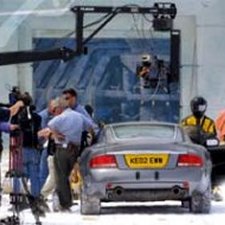 Now pay attention, 007. It’s an amazing twenty years since Pierce Brosnan’s final movie as James Bond hit our cinema screens. On 18th November, 2002, Brosnan’s fourth Bond adventure Die Another Day had its Royal Premiere at the Royal Albert Hall in central London, in front of the Queen and Prince Philip, and was released to UK cinemas on 20th November.
Now pay attention, 007. It’s an amazing twenty years since Pierce Brosnan’s final movie as James Bond hit our cinema screens. On 18th November, 2002, Brosnan’s fourth Bond adventure Die Another Day had its Royal Premiere at the Royal Albert Hall in central London, in front of the Queen and Prince Philip, and was released to UK cinemas on 20th November.
True to form, it delivered both a typically ‘Bondian’ plot (dastardly villain, treason and betrayal, hi-tech weaponry, a gigantic ice-palace, and so on) and some truly spectacular action sequences.
But have you ever wondered about what happens behind the scenes when they film a new James Bond film, and about the sheer logistical, creative and other production challenges involved in putting 007 on the big screen? On the 20th Anniversary of Bond 20, the JBIFC takes the opportunity to explore some of these questions and the enormous challenges that were involved in the production of 2002’s Die Another Day (DAD).
007 and Counting…
001: From Pen to Screen. Pierce Brosnan’s fourth and final adventure as 007, Die Another Day (2002), the 20th entry in the iconic series, marked the 40th anniversary of the EON franchise. The first major challenge involved in realising a new James Bond movie is coming up with a basic storyline, something that will inevitably be subjected to numerous changes and developments over time (a pattern that has also characterised the Daniel Craig cycle of Bond screen treatments more recently).
The pre-production writing duties on the 20th James Bond movie began very shortly after the release of The World Is Not Enough (1999). As early as the summer of 2000, screenwriters Neal Purvis and Robert Wade, began the process of ‘brainstorming’ concepts for ‘Bond 20’, trying out new ideas with the EON producers, Barbara Broccoli and Michael G. Wilson. Purvis and Wade quickly realised that the producers were looking for something very special to mark the 40th anniversary, a film that would tap into past 007 nostalgia but, at the same time, also deliver something fresh and distinctively 21st century. However, the veteran writing pair were under no illusions about the enormous challenges posed by Bond 20: they commented at one point: ‘People might think writing a Bond film is easy – you’ve got Bond, M, Q, Moneypenny, some beautiful girls and a villain. But that’s what makes it actually quite daunting. How do you make it all seem fresh and new?’
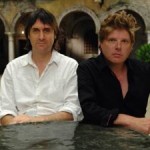
The talented screenwriting duo explained in later interviews that it was generally agreed in the year 2000 that Bond 20 would be on a grand scale, reminiscent of You Only Live Twice (1967), and drawing upon some characters and story themes inspired by Ian Fleming’s third 007 novel Moonraker. In particular, Purvis and Wade both felt that there were some interesting aspects of Fleming’s third James Bond book that had not been fully utilised, especially the idea of a confrontation in the Blades Club, a gentleman’s club in London. Moreover, the central character of Sir Hugo Drax – a seemingly patriotic knighted industrialist who has secret plans for revenge using a hi-tech weapon (a new missile) in the Fleming novel – appeared ripe for further exploration.
Drax became ‘Gustav Graves’ in the final DAD script, of course: a seemingly philanthropic industralist with a concern for the world’s environment, and the hi-tech weapon became ‘Icarus’, an orbital mirror satellite, which is able to focus solar energy onto a small area to provide year-round sunshine for maximum crop development. In reality, though, Graves is secretly plotting to use Icarus as a kind of laser-emitting weapon of war. In line with this hi-tech and scientific dimension, it was also felt that the movie would benefit from a ‘global’ backdrop, the story moving swiftly from country to country. As with all 007 movies, it was a challenge to find something a bit different, even quirky, but still recognizably ‘Bondian’. James Bond producer Barbara Broccoli had read a newspaper article about a small hotel in Sweden made completely of ice, and thought this would make an excellent story-point and sequence for the movie, so Purvis and Wade also integrated this into the storyline, providing the villain with a snow-bound Ice Palace hotel and lair for the second half of the film.
To realise this big vision, the EON producers chose the New Zealand-born director Lee Tamahori. Barbara Broccoli had been particularly impressed with Tamahori’s movie Once Were Warriors (1994). The new 007 movie was also given a $142m budget.
002: From a View to a Thrill. Some early footage for the movie was taken on Christmas Day in 2001, when a small shooting unit began work in Hawaii, filming some material for the breathtaking surfing sequences that were to appear in the pre-credits to the movie. Principal photography on DAD commenced in mid-January, 2002, and lasted nearly six months. It was a complex operation, requiring full co-ordination across a number of different units. After full shooting had started, and after about four months of hard work, the sheer logistical challenge faced by the crews was very apparent. But director Lee Tamahori was under no illusions about the huge demands of supervising the various film units. As he commented later, ‘that’s the pressure you put up with to join one of the most illustrious clubs of directors in film history’.
In fact, by June, 2002, with the end of shooting nearly in sight, no less than seven film units were filming simultaneously, and Tamahori and his teams were under intense pressure to deliver the completed movie for the world premiere on 18th November, 2002. This network of shooting units included a First, a Second, and a Third unit for main filming, plus special units were created for aerial, underwater and minature work. Whoever said film-making is easy?
003: Global Eye. It is no exagerration to say that, in many ways, each new Bond production has often been more and more ‘international’ in both its production and plotline, and DAD very much moved in this global location direction.
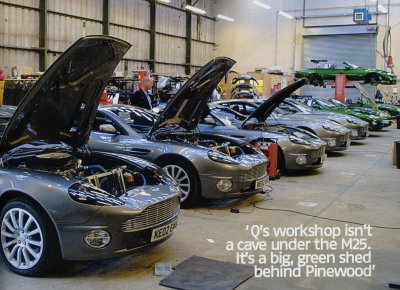 The storyline for DAD envisaged a variety of countries being used. However, movie-making is very much the art of illusion, so the globe-trotting movements of 007 do not necessarily mean he really went to those countries! In terms of actual shooting locations for Die Another Day, a large amount of work was still carried out in England, especially at the EON franchise’s traditional home of Pinewood Studios.
The storyline for DAD envisaged a variety of countries being used. However, movie-making is very much the art of illusion, so the globe-trotting movements of 007 do not necessarily mean he really went to those countries! In terms of actual shooting locations for Die Another Day, a large amount of work was still carried out in England, especially at the EON franchise’s traditional home of Pinewood Studios.
According to Vic Armstrong, the Second Unit director and stunt coordinator on the movie, when he first read an early draft of the script, he was very excited to find that locations included Korea and Japan. Japan was dropped fairly early on, though, while the Korean sequences were mainly shot in England and Hawaii. Some plans for an ice yacht race to be shot in north America, by the Great Lakes, were also dropped.
Location managers are highly-skilled at finding places that more-or-less match the countries supposedly being portrayed on the screen. Although the Ice Palace hotel was built at Pinewood, location work was also carried out on the roof and in the interiors of the huge bio-domes of the Eden Project in Cornwall. A beach at Holywell Bay, in Cornwall, was also used as North Korean coastal territory, while an army base in Aldershot in Hampshire, a redundant cement works at Chinnor in Oxfordshire, and the backlot at Pinewood were also all utilised for the pre-credits hovercraft chase sequences.
004: Live and Let Hover. The former cement works at Chinnor, where the final sequences in the hovercraft chase were filmed, proved especially challenging; at one point, even though the filming was taking place in June (usually the height of summer in England), some recent very wet weather had turned the set into a sea of grey mud, leaving the unit having to scrape the top layer off the dirt track with heavy machinery. On the other hand, in terms of continuity, even though some of the main hovercraft sequences had been shot three months previously at Aldershot and at Pinewood in muddy conditions, the grey weather that summer at Chinnor proved surprisingly helpful!
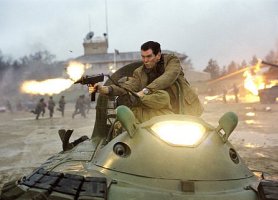 Similarly, just as a fair number of sequences were shot at locations fairly close to the home-base at Pinewood, some of the early sequences in the movie were filmed relatively close to home – in Europe. The Cuban sequences were actually shot in Spain, at Cadiz (doubling for Havana) and also at La Caleta. This is not as easy as it sounds: moving a film crew abroad means having to shift a large amount of equipment, set up a temporary production office, and find hotel accommodation for a large number of people, often months in advance. And, as Halle Berry would undoubtedly confirm (she had to emerge from the sea in a bikini), even though the beach at Cadiz looked very sunny on film, it was unusually cold! On the other hand, the production of the movie was still, in other ways, truly ‘international’. Apart from some footage shot at Svalbard, Norway, undoubtedly the most challenging set of sequences in terms of international locations was the amazing stunt work shot with duelling cars in Iceland.
Similarly, just as a fair number of sequences were shot at locations fairly close to the home-base at Pinewood, some of the early sequences in the movie were filmed relatively close to home – in Europe. The Cuban sequences were actually shot in Spain, at Cadiz (doubling for Havana) and also at La Caleta. This is not as easy as it sounds: moving a film crew abroad means having to shift a large amount of equipment, set up a temporary production office, and find hotel accommodation for a large number of people, often months in advance. And, as Halle Berry would undoubtedly confirm (she had to emerge from the sea in a bikini), even though the beach at Cadiz looked very sunny on film, it was unusually cold! On the other hand, the production of the movie was still, in other ways, truly ‘international’. Apart from some footage shot at Svalbard, Norway, undoubtedly the most challenging set of sequences in terms of international locations was the amazing stunt work shot with duelling cars in Iceland.
005: Shaken and Very Stirred. The location chosen, at the frozen Lake Jokulsarlon, near Hofn in Iceland, was at the south end of the eye-catching and truly beautiful glacier Vatnajokull, one of the largest glaciers in Europe. The scenes with Bond’s Aston Martin V12 Vanquish and Zao’s Jaguar XKR, envisaged by stunt coordinator Vic Armstrong as a kind of ballet-style duel on ice, involved a large amount of very careful preparation and detailed Health and Safety planning. The ice on the frozen lake was only ten-inches thick, and every member of the crew involved had to wear special survival suits just in case the ice broke. Only a certain number of crew members were allowed on to the lake at any one time. Moreover, each car on the ice (including the back-up ones) had to be kept at a certain distance from one another, to help spread the weight.

The sequence also involved considerable work on the cars beforehand; Chris Corbould and his team worked at Pinewood on converting each car to four-wheel drive (to cope with the ice), and this meant spending over a million pounds on this operation alone! Moreover, in a sense, to quote one comment made at the time, ‘Q’s workshop isn’t a cave under the M25. It’s a big, green shed behind Pinewood’. Staying on the art of illusion, not many people realise that a small segment of the car fight on the ice was finished off not in Iceland, but on a large chunk of land at a business centre at Bourton-on-the-Water, in the Cotswolds area of Gloucestershire, England. This part of the filming, which took place in June, 2002, involved creating numerous ice caps and a large amount of ice and ‘snow’ in the background. Isn’t film-making wonderful? The explanation for using an English location for this wa that, due to the complexity of the stunt where Bond’s Aston Martin flips over onto its roof, it was felt that this was simply too dangerous to attempt to do on the ice in Iceland.
006: Try Another Way. Even though, in one sense, each Bond movie is unique, in another sense the process of 007 movie-making has certain common organizational patterns. So, how does the behind-the-scenes story of a past 007 movie like DAD help us with understanding the enormous challenges that the Bond producers will be facing on the next (still un-titled) 007 adventure (Bond 26)?
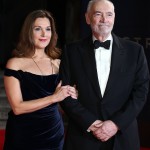
Regarding the ‘producing’ side to a new Bond film, both Barbara Broccoli and Michael G. Wilson have been very clear in various interviews over the years about the enormous challenge that each new entry in the franchise presents. Bond 20 was a real test. Bond 26 will be no different. Wilson, speaking in April, 2013, for example, said it had always been ‘a challenge’ to maintain the 007 franchise’s appeal to audiences, and ‘for 50 years’ they had been trying to keep it ‘current and exciting’.
Nevertheless, at the same time, the veteran producers clearly enjoy such a test, and have carved out a huge reputation in the film industry for being able to overcome challenges that would simply defeat many other people. Significantly, in January, 2014, when the EON duo were given the highly prestigious David O. Selznick Achievement Award in Motion Pictures, Wilson said that their father, Cubby Broccoli, had taught them ‘not to fear failure but to learn from it’; he said Cubby had also taught them that it is a producer’s job to inspire the cast and crew, ‘to act as a sounding board for the director’, and to be their advocate with the studio. This philosophy was certainly seen in action on DAD. The producers participated in regular script discussion meetings and, as on previous Brosnan 007 films, were often on set to observe the proceedings and provide moral and other support for the director Lee Tamahori and members of the principal cast.
On the other hand, both Broccoli and Wilson recognised that DAD had probably pushed the outlandish sci-fi direction of the franchise to its limit and there would now have to be a radical change of direction. And, despite the huge box-office success of DAD, they took the difficult and (at the time) controversial decision to change the course of the series and go ‘back to basics’ (as it were) with a new actor and a new approach.
007: Golden Die. The final challenge for any new Bond film is the title. As was the case with Bond 20, possibly one of the most formidable hurdles for Bond 26, for example (apart from finding a new 007 actor!) will undoubtedly be what to actually call the new movie. As with the situation that faced Bond 20, there are very few original Fleming story titles left, and often the pressure from both the main studios and the marketing people is to have a short, sharp and snappy title, something that will also easily translate into foreign markets. Skyfall, for example, fulfilled this brilliantly, as did Spectre. It will be fascinating to see what title Bond 26 is awarded. Three-word titles also work well in most languages, and often also satisfy marketing departments.
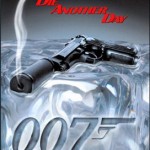
There was a lot of speculation about what Bond 20 would be called in the run-up to the production of the movie, and numerous rumours and false stories on this appeared during the shooting of the film. One story that has been told over the years, and has a ring of truth to it, is that the title came about after a comment made by Robert Wade in a script meeting; Wade, describing a key element of the story, had said ‘Bond lives to die another day’. When Barbara Broccoli, who was present, heard this she suddenly exclaimed ‘That could be the title!’ Background research on the title then discovered something very interesting. It had previously appeared in a famous poem. This enabled the studio marketing people to say in publicity releases that the title for Die Another Day had been taken from a verse by the poet A.E. Houseman (1859-1936). In A Shropshire Lad (1896), one verse (about the nature of battle) explores whether it is better for a soldier to fight or to run away, and it hints that to run away will merely extend a soldier’s life for a brief time, leaving him just to ‘die another day’. Michael G. Wilson was especially pleased about the title, commenting that it was ‘very Fleming’ in tone.
Did You Know?
The very Fleming-esque word ‘Die’ has now been used in four James Bond film titles: Live and Let Die; Tomorrow Never Dies; Die Another Day; and No Time To Die. Roger Moore’s debut 007 movie Live and Let Die, of course, was the only original Ian Fleming title. Interestingly, in the case of Tomorrow Never Dies, Pierce Brosnan’s second James Bond adventure, the word ‘Dies’ came about as the result of a spelling error. The scriptwriter Bruce Ferstein had originally titled the storyline as Tomorrow Never Lies, but when a UA press release was being prepared to announce the title, a publicist had mistakenly typed ‘Tomorrow Never Dies’. The production team decided that, actually, this was in fact a better title! The rest, as they say, is history.
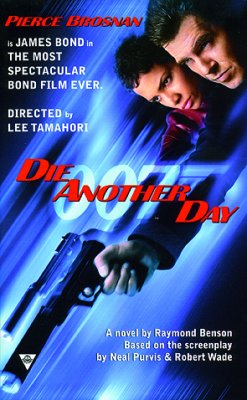
Publicity blurb for both the film and the tie-in novel.
